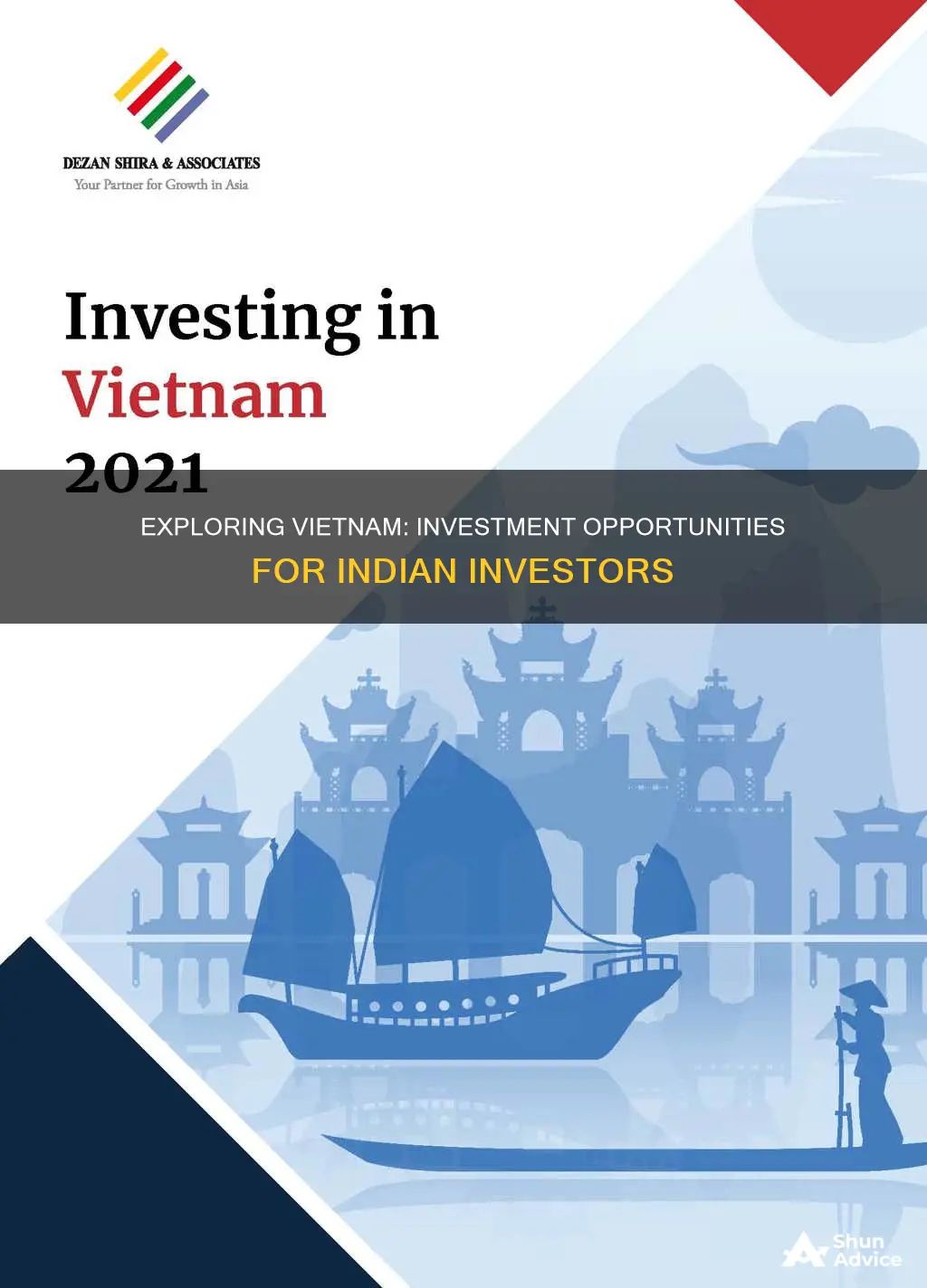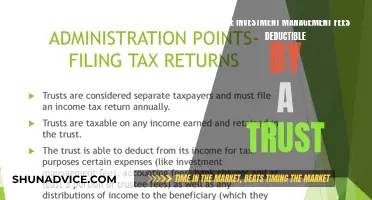
India and Vietnam have historically strong bilateral relations, with India ranking among Vietnam's top ten trading partners. Bilateral trade between the two countries has been steadily rising over the past two decades, with Indian exports to Vietnam amounting to US$5.9 billion in 2022-23, and Indian imports from the country reaching US$8.79 billion. Vietnam's favourable investment policies, stable and growing economy, and low labour costs make it an attractive destination for foreign investors. However, investing in Vietnam stocks as a foreigner is still restrictive due to foreign ownership limitations. So, how can Indian investors gain exposure to the Vietnamese market?
| Characteristics | Values |
|---|---|
| India-Vietnam trade volume | US$1.1 billion |
| India's rank among Vietnam's top trading partners | 7th |
| Vietnam's rank among India's top trading partners | 18th |
| Indian exports to Vietnam | Mobile phones, electronic components, machinery, computer technology, natural rubber, chemicals, coffee, meat and fishery products, corn, steel, pharmaceuticals, cotton, machinery |
| Indian imports from Vietnam | Electrical machinery and equipment, iron and steel, nuclear reactors, boilers, machinery, mechanical appliances, copper and copper products, inorganic chemicals |
| Indian investments in Vietnam | US$1.9 billion |
| Number of Indian investment projects in Vietnam | Over 200 |
| Indian investment sectors in Vietnam | Energy, mineral exploration, agrochemicals, sugar, tea, coffee manufacturing, IT, auto components |
| Vietnam's stock exchanges | Ho Chi Minh Stock Exchange (HOSE), Hanoi Stock Exchange (HNX) |
| Vietnam's largest company by market capitalization | Vingroup |
| Vietnam's advantages for investors | Stable political environment, low labour costs, high growth prospects, favourable investment policies, free trade agreements, economic growth, political stability, young workforce |
What You'll Learn

Vietnam's stock market and foreign ownership limitations
Vietnam offers a favourable environment for investment, with different regions offering business-friendly policies, investment incentives, competitive labour rates, and land rents. The country has two major stock exchanges: the Ho Chi Minh Stock Exchange (HOSE) and the Hanoi Stock Exchange (HNX). In 2020, these two exchanges were merged into one platform called the Vietnam Stock Exchange, with HOSE serving as the sole equity exchange.
The Ho Chi Minh Stock Exchange has a market capitalization of around US$225 billion and holds more than 700 listed stocks. Trading hours are from 9 AM to 3 PM, with a break from 11:30 AM to 1 PM.
The Hanoi Stock Exchange, on the other hand, has a market capitalization of around US$50 billion and holds about US$200 million worth of bonds. Its trading hours are the same as that of the Ho Chi Minh Stock Exchange.
Foreigners can invest in both of Vietnam's major exchanges through the Vietnam Stock Exchange platform. However, there are some limitations and restrictions regarding foreign ownership and foreign majority holdings that investors should be aware of.
Most publicly traded Vietnamese companies are subject to a foreign ownership limitation of 49 percent. However, new laws that came into effect in early 2021 provide a path for public companies to increase foreign ownership to 50% or above or even remove foreign ownership restrictions with the consent of the State Securities Commission (SSC).
Foreign ownership caps on companies operating in "sensitive and important" sectors such as security, defence, telecommunication, and insurance will remain at 49 percent. The limit for banks will stay at 30 percent.
To invest in Vietnam's stock market, foreigners typically need to open a brokerage account in Asia. Vietnam's biggest stockbrokers are more likely to have English speakers and are generally more competent compared to smaller firms. Saigon Securities Incorporation, Ho Chi Minh City Securities Corporation, and Viet Capital Securities Joint Stock Company are some of the largest brokerage companies in Vietnam by market share.
Additionally, several Vietnam ETFs (Exchange-Traded Funds) are traded outside the country, such as Vietnam Enterprise Investments Limited (LON: VEIL) in the United Kingdom and Vaneck Vectors Vietnam (NYSEARCA: VNM) in the United States. These ETFs offer broad exposure to Vietnamese equities, but investing in individual stocks may provide more direct and cost-effective access to Vietnam's market.
Vietnam's stock market has seen significant improvements in accessibility over the past decade, and recent changes have made it easier for foreigners to invest in the country.
Lucrative Ways to Earn Money in India Without Investment
You may want to see also

India-Vietnam trade and investment relations
India and Vietnam have historically shared close and cordial bilateral relations, rooted in their common struggle for liberation from colonial rule. In recent years, economic ties have materialized into several Indian investments in Vietnam across various sectors. Bilateral trade has been steadily rising over the past two decades, with the value reaching US$14.69 billion in the fiscal year 2022-23. Indian exports to Vietnam amounted to US$5.9 billion, while imports from Vietnam totalled US$8.79 billion.
Trade Opportunities
India has significant expertise in IT services, pharmaceuticals, and oil and gas, which can benefit Vietnam. There is also export potential in zinc, iron, steel, and man-made staple fibres from India to Vietnam. Vietnam, in turn, can export mobile phones, electronic components, machinery, computer technology, natural rubber, chemicals, and coffee to India.
Investment Opportunities
Vietnam's strategic location, favourable investment policies, free trade agreements, economic growth, and political stability make it an attractive destination for foreign investment. The country offers competitive labour rates, land rents, and business-friendly policies.
India has invested nearly US$2 billion in Vietnam, with a focus on sectors such as energy, mineral exploration, agrochemicals, sugar, tea, coffee manufacturing, IT, and auto components. Over 200 Indian investment projects are underway in Vietnam, with major companies like Adani Group, Mahindra, SRF, and Suzlon venturing into the country.
Facilitating Trade and Investment
Both governments actively work to facilitate trade and investment by increasing air connectivity and improving direct containerization. These efforts have led to the launch of direct flights connecting Indian and Vietnamese cities.
Challenges and Risks
Despite the positive trajectory, challenges remain. India's decision to opt out of the Regional Comprehensive Economic Partnership (RCEP) may impact trade. Additionally, Vietnam's strict stock market regulations and foreign ownership limitations can restrict the inflow of foreign capital and impact stock market valuations.
Understanding Boutique Investment Management Firms: A Niche Focus
You may want to see also

Vietnam's favourable investment policies
Vietnam has a favourable environment for investment, with different regions offering business-friendly policies, competitive labour rates, and land rents. Here are some of the key aspects of Vietnam's favourable investment policies:
Political Stability and Economic Growth
Vietnam's political and security environment is largely stable, and the country has experienced strong economic growth over the years. The country's successful handling of the COVID-19 pandemic, proactive health policies, and fiscal and monetary stimulus measures have contributed to its economic resilience.
Free Trade Agreements
Vietnam has been actively pursuing free trade agreements (FTAs) to enhance its market access and attract foreign investment. The country is a member of the ASEAN-India Free Trade Area (AIFTA) and has signed agreements with the EU, the UK, and is part of the Regional Comprehensive Economic Partnership (RCEP). These agreements reduce trade barriers and provide preferential access to participating countries, making Vietnam an attractive investment destination.
Investor-Friendly Reforms
Vietnam has implemented various investor-friendly reforms to simplify regulations and promote transparency. The government has removed foreign ownership limits in most industries and simplified procedures for foreign investors. Additionally, Vietnam has passed laws to encourage foreign investment in large infrastructure projects and increase collaboration with the Vietnamese private sector.
Competitive Labour Costs and Skilled Workforce
Vietnam offers competitive labour costs, with a large and increasingly educated and urbanized workforce. The country's young population and growing number of skilled workers make it an attractive destination for businesses looking to establish manufacturing and production hubs.
Investment Incentives
Vietnam offers investment incentives in various sectors, including advanced technology, research and development, clean energy, renewable energy, automobiles, and software. These incentives include lower corporate income tax rates, exemption from certain import tariffs, and favourable land rental rates.
Strong Bilateral Relations with India
India and Vietnam share strong bilateral relations, with significant trade potential estimated at US$1.1 billion. India's expertise in IT services, pharmaceuticals, and oil and gas can benefit Vietnam's growing economy. Additionally, Vietnam's strategic location and access to Southeast Asian markets make it an attractive investment destination for Indian businesses looking to diversify their supply chains.
Infrastructure Development
Vietnam has prioritized the development of industrial parks and economic zones, making it easier for foreign investors to implement projects. The country's stable banking sector and improving business registration processes further enhance its investment prospects.
Challenges and Opportunities
While Vietnam offers favourable investment policies, investors should also be aware of certain challenges. These include widespread corruption, regulatory uncertainty, intellectual property rights enforcement, and land disputes. However, Vietnam is actively working to address these issues, and its strong fundamentals and growth potential make it an attractive destination for investors with a long-term outlook.
Monero Investment Guide for Indians: Getting Started
You may want to see also

India's exports to Vietnam
In the financial year 2019-2020, bilateral trade between India and Vietnam was valued at US$12.3 billion, up from US$200 million in 2000. India's exports to Vietnam in 2023-2024 were valued at US$5.47 billion.
Key exports from India to Vietnam include frozen bovine meat, cereal, iron and steel, cotton, animal fodder and materials, fishery products, electrical equipment, machinery and equipment, aluminium, auto components, chemicals and chemical products, ordinary metals, pharmaceuticals, and gems and jewellery.
India's expertise in IT services, pharmaceuticals, and oil and gas can be of significant benefit to Vietnam. There are also export opportunities in zinc, iron, steel, and man-made staple fibres from India to Vietnam.
India's large middle class and customs-duty exemption for ASEAN products make it a lucrative destination for Vietnamese exports. There is also scope for the development of services related to wholesale and retail trade, transportation and storage, and business support, along with trade opportunities in cotton and knitted clothing.
Vietnam offers a favourable investment environment, with different regions offering business-friendly policies, competitive labour rates, and land rents. The country has also simplified its regulations over time, making it easier for foreign investors to access the market.
Do Investment Managers Beat the Market Index?
You may want to see also

Vietnam's economic zones and industrial parks
Economic Zones
Vietnam's economic zones (EZs) are large areas with defined geographical boundaries that encompass industrial, commercial, and residential activities. They are often strategically located near major transport infrastructure to facilitate smooth logistics and reduced transportation costs. EZs were established to attract investment, promote socio-economic development, and maintain national defence and security.
There are four main EZs in Vietnam:
- Northern Key Economic Region (NKER): Covers seven provinces, including Hanoi, Hai Phong, and Quang Ninh. The proximity to China makes it a popular alternative for companies moving manufacturing operations from China.
- Central Key Economic Region (CKER): Covers five provinces, including Thua Thien Hue and Da Nang. It has the largest port area, offering potential for maritime transport and tourism.
- Southern Key Economic Region (SKER): Comprises eight provinces, including Ho Chi Minh City and Binh Duong. This region has the highest number of industrial parks and is known for its manufacturing capabilities.
- Mekong Delta Economic Region (MDKER): Consists of four provinces, including Can Tho and An Giang. The government is promoting this region with attractive incentives for industries such as digital economy, biotechnology, and high-tech agriculture.
Industrial Parks
Industrial parks (IPs) are areas with defined boundaries within EZs that specialize in the production of industrial goods and services. They aim to attract local and foreign investment by providing an ecosystem of suppliers, manufacturers, and service providers, reducing lead times and accelerating production cycles. IPs mainly cover production activities and can sometimes be found within EZs.
Some types of IPs include:
- Export Processing Zones
- High-Technology Zones
- Eco-Industrial Zones
Advantages of Operating in Vietnam's Economic Zones and Industrial Parks
- Competitive Costing: Vietnam's EZs and IPs offer cost-efficient environments with lower overhead costs, tax breaks, and financial incentives, providing a competitive edge in the global market.
- Infrastructure Setup: EZs and IPs are strategically positioned near transportation routes and are equipped with modern utilities, communication networks, and facilities.
- Integrated Ecosystem: IPs, in particular, foster collaboration and reduce lead times by bringing together suppliers, manufacturers, and service providers.
- Stable Political System: Vietnam's stable political environment contributes to its appeal as an investment destination.
- Young and Dynamic Workforce: Vietnam's young population provides a dynamic and skilled labour force for businesses.
- Competitive Labour Costs: Vietnam offers competitive labour rates, making it attractive for manufacturing and production industries.
Building a Tax-Efficient Investment Portfolio: Strategies for Success
You may want to see also
Frequently asked questions
Vietnam offers a favourable business environment with business-friendly policies, investment incentives, competitive labour rates, and land rents. It has a stable political environment, low labour costs, and high growth prospects. The country has also risen in ease of doing business rankings, making it an attractive destination for foreign investors.
Vietnam offers investment opportunities in various sectors, including energy, mineral exploration, agro-processing, sugar, tea, coffee manufacturing, agro-chemicals, IT, auto components, pharmaceuticals, textiles, and tourism.
Foreign entities, including Indian investors, can establish their presence in Vietnam in several ways, including as a limited liability company, a joint-stock company, a partnership, a branch, a business cooperation contract, or a representative office.
Foreign investors need to open accounts with brokerages and banks in Vietnam to trade stocks listed on the Ho Chi Minh Stock Exchange (HOSE) directly. They can also invest in stocks of companies with significant exposure to Vietnam, such as VinaCapital Vietnam Opportunity Fund (VOF) and Vietnam Enterprise Investments (VEIL). Additionally, index funds that track the performance of Vietnamese equity indices are a popular and convenient way to gain exposure to the Vietnamese stock market.
The strict stock market regulations and foreign ownership limitations in Vietnam restrict the inflow of foreign capital and may impact price appreciation. Other risks include macroeconomic factors such as hyperinflation, foreign exchange rate fluctuations, geopolitical conflicts, and recessions. Company-specific risks, such as poor earnings and management controversies, can also affect stock market valuations.







